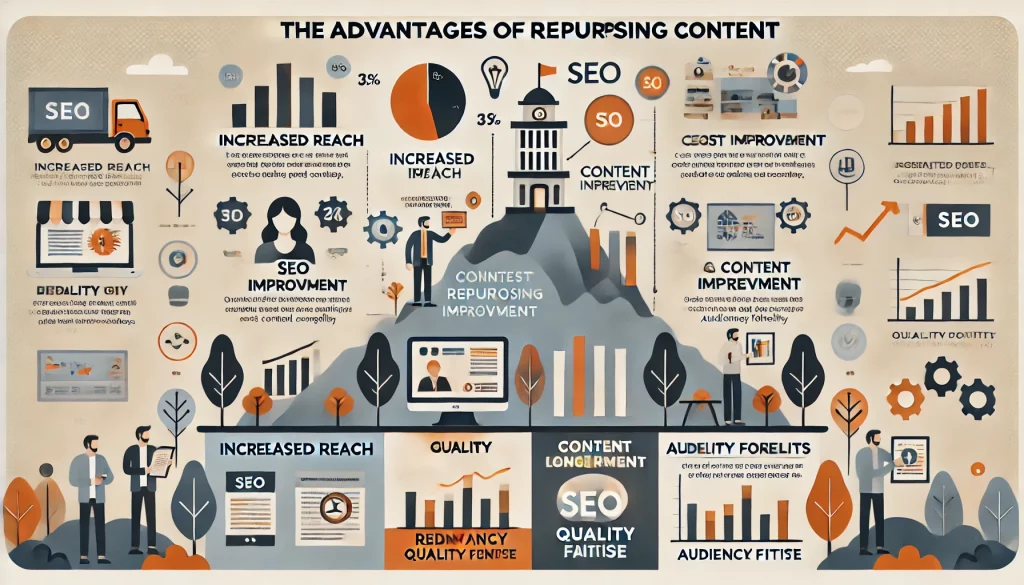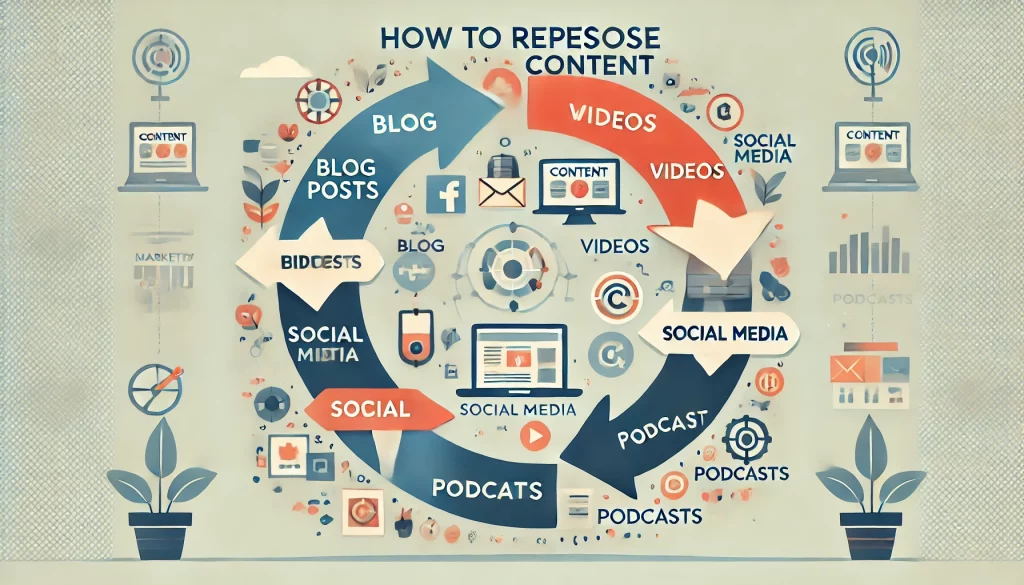Content is king, and creating high-quality, engaging content takes time, effort, and resources.
| Recent studies show that 60% of marketers create at least one piece of content per day, highlighting the growing importance of content marketing in the digital landscape. |
In an age where efficiency and sustainability are essential, repurposing content offers a powerful way to maximize your content’s impact while reducing your carbon footprint.
According to best content writing services in Hyderabad, by reusing and recycling content, you not only increase its reach and visibility but also contribute to a more sustainable approach to content creation.
In this article, we’ll discuss the importance of content repurposing, explore its advantages and disadvantages, and present three case studies of successful content repurposing strategies.
Additionally, we’ll provide actionable steps for repurposing content and address frequently asked questions on the topic.
5 Step Strategy for Content Repurposing and Reducing the Carbon Footprint
Content repurposing is a powerful strategy that allows you to leverage your existing content and reach new audiences, boost SEO, and maximize your content marketing ROI. Here’s a detailed breakdown of the 5-step strategy for content repurposing, complete with examples and statistics.
-
Audit Your Existing Content:
Start by reviewing your existing content to identify the top-performing pieces that can be repurposed. Look for evergreen content, high-traffic posts, or pieces that have generated significant engagement.
Example: Suppose you have a blog post about “10 Ways to Improve Employee Productivity” that has garnered high traffic and engagement. This piece can be repurposed into various formats.
| According to HubSpot, marketers who prioritize blogging efforts are 13 times more likely to see positive ROI. |
-
Determine New Formats:
Once you’ve selected content to repurpose, consider the different formats that would best suit the material. Popular formats include blog posts, infographics, videos, podcasts, social media posts, and email newsletters.
Example: The “10 Ways to Improve Employee Productivity” blog post can be repurposed into an infographic, a YouTube video, a podcast episode, a series of social media posts, or a part of an email newsletter.
| According to the Content Marketing Institute, 85% of marketers used repurposed content in their marketing efforts in 2020. |
-
Adapt Your Content:
Tailor the content to fit the new format while maintaining its core message. Be mindful of the target audience and platform-specific nuances when adapting content for different channels.
Example: When converting the “10 Ways to Improve Employee Productivity” blog post into an infographic, focus on visually representing the key points and statistics, while for a podcast episode, delve into a more conversational approach with anecdotes and expert interviews.
| Cisco projects that by 2022, video traffic accounts for 82% of all consumer internet traffic. Therefore, adapting content into video format can help you tap into a massive audience. |
-
Optimize for SEO:
According to Banter Marketo, Ensure your repurposed content is optimized for search engines by incorporating relevant keywords, meta tags, and alt text. This will improve your content’s visibility and drive organic traffic.
Example: When repurposing the “10 Ways to Improve Employee Productivity” blog post into a video, use the target keyword in the title, description, and tags. Similarly, when creating an infographic, use the target keyword in the image’s file name and alt text.
| According to Ahrefs, the top-ranking page gets 49% of the total search traffic for a given keyword, highlighting the importance of optimizing your content for SEO. |
-
Track Performance:
Monitor the performance of your repurposed content using analytics tools and adjust your strategy as needed to maximize its impact.
Example: Use Google Analytics to track traffic, engagement, and conversions from your repurposed content. If the YouTube video version of the “10 Ways to Improve Employee Productivity” post isn’t performing as expected, consider testing different thumbnail designs, titles, or descriptions to improve its performance.
| According to Databox, 63% of marketers use Google Analytics to track their content marketing efforts. |
By following this 5-step strategy for content repurposing, you can maximize the value of your existing content, extend its reach, and improve your overall content marketing performance.
Advantages of Content Repurposing
- Increased Reach: Repurposing content allows you to reach new audiences by catering to different content preferences and platforms.
- Improved SEO: Repurposing content provides additional opportunities to target relevant keywords, boosting your search engine rankings.
- Time and Resource Efficiency: Reusing content saves time and resources, allowing you to focus on other aspects of your marketing strategy.
- Enhanced Authority: By consistently providing valuable content in various formats, you can establish yourself as an authority in your niche.
Disadvantages of Content Repurposing
- Risk of Redundancy: Overusing the same content can lead to redundancy and disengagement from your audience.
- Quality Dilution: Repurposing content without maintaining its quality can harm your brand reputation and credibility.
- Ineffectiveness: Some content may not translate well across different formats or platforms, resulting in diminished impact.

Case Study 1: Buffer’s “25 Days of Social Media Growth” Email Course
Background:
Buffer is a popular social media management tool that helps businesses and individuals schedule and manage their social media content. As part of their content marketing strategy, Buffer decided to repurpose their existing blog content into a new format: an email course.
Objective:
The goal was to generate more leads, increase blog traffic, and establish Buffer as an authority in social media marketing.
Strategy:
Buffer carefully analyzed their blog content and selected 25 high-performing articles related to social media growth. They repackaged these articles into bite-sized lessons and created a comprehensive email course called “25 Days of Social Media Growth.”
Results:
The email course was a huge success, with over 18,000 sign-ups. Additionally, the campaign led to a 40% increase in blog traffic, as more people discovered Buffer’s valuable content through the course.
Case Study 2: HubSpot’s “Ultimate Guide to Productivity” eBook
Background:
HubSpot is an inbound marketing, sales, and customer service platform. As part of their content marketing efforts, they decided to repurpose a series of blog posts on productivity into a comprehensive eBook.
Objective:
The goal was to generate more leads, increase engagement with their content, and showcase HubSpot’s expertise in productivity and time management.
Strategy:
HubSpot selected several high-performing blog posts related to productivity and combined them into a single, cohesive eBook titled “The Ultimate Guide to Productivity.” The eBook was then promoted through various channels, including email marketing, social media, and their blog.
Results:
The eBook generated over 10,000 downloads in its first month, demonstrating the effectiveness of content repurposing in generating leads and driving engagement with their content.

Case Study 3: Moz’s “Whiteboard Friday” Multi-Format Content
Background:
Moz is a leading SEO software company known for its popular “Whiteboard Friday” video series, in which industry experts share valuable insights and tips on various SEO topics. To maximize the reach and impact of this content, Moz decided to repurpose the video series into multiple formats.
Objective:
The goal was to increase overall engagement, reach new audiences, and solidify Moz’s position as an authority in the SEO space.
Strategy:
Moz repurposed its “Whiteboard Friday” videos into blog posts, podcasts, and social media content. Each format was tailored to suit the preferences of different audience segments and distributed across various platforms, including their website, podcast streaming services, and social media channels.
Results:
By repurposing their video content into multiple formats, Moz achieved a 60% increase in overall engagement and expanded their audience reach. This multi-format approach allowed them to connect with a broader range of users and reinforce their reputation as a leading source of SEO knowledge and expertise.
Relevant FAQs
Q: How do I choose which content to repurpose?
A: Focus on evergreen content, high-performing pieces, or content that generated significant engagement. Analyze your existing content and prioritize pieces that have the potential to resonate with a broader audience.
Q: Can repurposing content negatively affect my SEO?
A: Repurposing content, when done correctly, can enhance your SEO. However, be careful not to create duplicate content, as this can negatively impact your search engine rankings. Always ensure that repurposed content is unique and valuable.
Q: How often should I repurpose content?
A: There’s no set rule for how often to repurpose content. The frequency depends on your content strategy, audience preferences, and the types of content that work best for your brand. Regularly evaluate the performance of your repurposed content and adjust your strategy accordingly.
Conclusion
Content repurposing offers a powerful, eco-friendly way to maximize the impact of your content while reducing your carbon footprint.
By following the detailed steps outlined in this article, you can effectively repurpose your content for different formats and platforms, reaching new audiences and driving engagement.
While there are potential disadvantages to content repurposing, careful planning and execution can ensure that your repurposed content remains valuable and effective.
Leverage the power of content repurposing to bolster your content marketing strategy, promote sustainability, and enhance your brand’s online presence.










